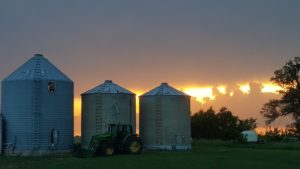
Mark with his grandson Hudson.
By Stefanie Pidgeon, Risk Management Agency, Public Affairs Specialist
Mark Nieman, a fourth-generation farmer in Nortonville, Kansas, is keeping the family’s farming tradition alive. Mark and his sons run the 620-acre corn, soybean, alfalfa and livestock farm in northeastern Kansas, which includes the 80 acres his great-grandfather bought back in 1905 when he emigrated from Germany.
Mark’s two boys and his grandkids, who will be the sixth-generation, are steadily helping more each year on the farm. “Living on the farm and preserving the ground for my family is most important,” he says. “I am very proud and lucky to have a family that wants to keep the Nieman legacy going.”
Roots in Farming
During the past six generations, the Niemans have produced a variety of crops and livestock. Mark’s grandfather, Ed, raised his five children on the original 80 acres, along with 10 cows, two sows, and chickens. He also sold milk and honey.
Mark remembers his grandfather farming with horses and a two-row lister, using chicken manure for fertilizer, and picking corn by hand. At the time, 30 to 50 bushels of corn yield was considered a success.
“I remember fishing with my grandfather at the pond on the property. The pond is still there and now I get to take my grandkids there to go fishing,” said Mark.
Ed also built a home on the property that has been lived in for five generations. “These are times I will never forget,” said Mark.
These days, the farm rotates among corn, soybeans and alfalfa as well as raises brome grass for their livestock. Plus, the Niemans plant about 5,000 seeds of sweet corn each year to feed the four families that call the farm home.
Off-the-Farm Job
Not only does Mark farm, he is also a long-time USDA employee. Currently, he serves as an investigator for USDA’s Risk Management Agency (RMA) in Kansas City, Missouri, where he investigates possible fraud, waste and abuse in crop insurance.

Mark hosted a field day for RMA employees at his farm to teach them about the operation.
“This helps protect the integrity of the program,” Mark says.
Before joining RMA in 2007, he worked for 33 years for USDA’s Farm Service Agency (FSA) in a number of jobs, including field assistant, field supervisor and county executive director. He started with FSA in 1974 after graduating from high school.
“I went with Dad to certify his crop acres at the FSA office in July of 1974,” he said. “They offered me a job that day as a field assistant to appraise corn, and I have had a job with USDA ever since.”
Mark and the rest of the family all have off-the-farm jobs. They do have help from an operator, but they do much of the work themselves.
“We take turns when needed to do the chores, cut and bale the hay or look after the cattle,” he said. “By spreading the workload, it also allows time to do church activities and watch your grandkids play summer ball.”
First-hand Experience
Mark knows firsthand the importance of USDA programs to American farmers. Over the years, he has grown, enhanced and protected his farm with the help of USDA.
His family was able to purchase most of its land with help from a farm loan from FSA. They also have crop insurance, which is delivered by private crop insurance companies and administered by RMA. Mark is now looking at Whole-Farm Revenue Protection, a safety net program to insure all commodities on a farm under one policy.
He was able to integrate a variety of conservation practices on his farm with the help of USDA’s Natural Resources Conservation Service (NRCS).

Mark and his family used USDA programs to purchase the farm, manage risks and make conservation improvements.
Mark and his family have worked with NRCS to rebuild old practices to make them more efficient. With NRCS’ help, the Nieman family revamped 50-year-old ditches into a tile terrace system, which can better curb erosion while gaining the farm more cropland.
The family also manages the farm with a conservation mindset, including their use of no-till for the past 13 years.
“In doing so, it has stopped ground erosion, conserved water and created less compaction in the soil,” Mark said.
He added: “Without the help of the USDA agencies of FSA, NRCS and RMA, I know we could not have bought the land and made the improvements to the soil. We are only here for a short period of time and really don’t own the land, we just preserve it for the next generation. Hopefully we can leave it better than we found it.”
JOIN THE CONVERSATION
For the digital version of this blog, visit #Fridaysonthefarm.
Follow the #Fridaysonthefarm story series and other news you can use on farmers.gov and @Farmersgov Twitter.





